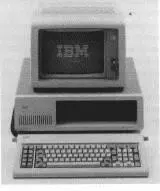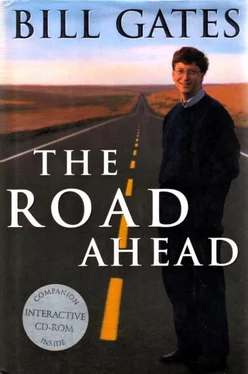While the duel between the Betamax and VHS formats was going on, sales of prerecorded videocassettes to U.S. tape-rental dealers were almost flat, just a few million copies a year. Once VHS emerged as the apparent standard, in about 1983, an acceptance threshold was crossed and the use of the machines, as measured by tape sales, turned abruptly upward. That year, over 9.5 million tapes were sold, a more than 50 percent increase over the year before. In 1984, tapes sales reached 22 million. Then, in successive years: 52 million, 84 million, and 110 million units in 1987, by which time renting movies had became one of the most popular forms of home entertainment, and the VHS machine had become ubiquitous.
This is an example of how a quantitative change in the acceptance level of a new technology can lead to a qualitative change in the role the technology plays. Television is another. In 1946, 10,000 television sets were sold in the United States and only 16,000 in the next year. But then a threshold was crossed, and in 1948 the number was 190,000. In successive years it was 1 million units, followed by 4 million, 10 million, and steadily up to 32 million sold in 1955. As more television sets were sold, more was invested in creating programming, which in turn further enticed people to buy television sets.
For the first few years after they were introduced, audio compact disc (CD) players and discs didn’t sell well, in part because it was difficult to find music stores that carried many titles. Then, seemingly overnight, enough players were sold and titles were available, and an acceptance threshold was crossed. More people bought players because more titles were available, and record companies made more titles available on CDs. Music lovers preferred the new, high-quality sound and convenience of compact discs, and they became the de facto standard and drove LPs out of the record stores.
One of the most important lessons the computer industry learned is that a great deal of a computer’s value to its user depends on the quality and variety of the application software available for it. All of us in the industry learned that lesson—some happily, some unhappily.
In the summer of 1980, two IBM emissaries came to Microsoft to discuss a personal computer they might or might not build.
At the time, IBM’s position was unchallenged in the realm of hardware, with a more than 80 percent market share of large computers. It had had only modest success with small computers. IBM was used to selling big, expensive machines to big customers. IBM’s management suspected that IBM, which had 340,000 employees, would require the assistance of outsiders if it was going to sell little, inexpensive machines to individuals as well as companies anytime soon.
IBM wanted to bring its personal computer to market in less than a year. In order to meet this schedule it had to abandon its traditional course of doing all the hardware and software itself. So IBM had elected to build its PC mainly from off-the-shelf components available to anyone. This made a platform that was fundamentally open, which made it easy to copy.
Although it generally built the microprocessors used in its products, IBM decided to buy microprocessors for its PCs from Intel. Most important for Microsoft, IBM decided to license the operating system from us, rather than creating software itself.
Working together with the IBM design team, we promoted a plan for IBM to build one of the first personal computers to use a 16-bit microprocessor chip, the 8088. The move from 8 to 16 bits would take personal computers from hobbyist toys to high-volume business tools. The 16-bit generation of computers could support up to one full megabyte of memory—256 times as much as an 8-bit computer. At first this would be just a theoretical advantage because IBM initially intended to offer only 16K of memory, 1/64 of the total memory possible. The benefit of going 16-bit was further lessened by IBM’s decision to save money by using a chip that employed only 8-bit connections to the rest of the computer. Consequently, the chip could think much faster than it could communicate. However, the decision to use a 16-bit processor was very smart because it allowed the IBM PC to evolve and remain the standard for PCs to this day.
IBM, with its reputation and its decision to employ an open design that other companies could copy, had a real chance to create a new, broad standard in personal computing. We wanted to be a part of it. So we took on the operating-system challenge. We bought some early work from another Seattle company and hired its top engineer, Tim Paterson. With lots of modifications the system became the Microsoft Disk Operating System, or MS-DOS. Tim became, in effect, the father of MS-DOS.
IBM, our first licensee, called the system PC-DOS; the PC was for personal computer. The IBM Personal Computer hit the market in August 1981 and was a triumph. The company marketed it well and popularized the term “PC.” The project had been conceived by Bill Lowe and shepherded to completion by Don Estridge. It is a tribute to the quality of the IBM people involved that they were able to take their personal computer from idea to market in less than a year.
Few remember this now, but the original IBM PC actually shipped with a choice of three operating systems—our PC-DOS, CP/M-86, and the UCSD Pascal P-system. We knew that only one of the three could succeed and become the standard. We wanted the same kinds of forces that were putting VHS cassettes into every video store to push MS-DOS to become the standard. We saw three ways to get MS-DOS out in front. First was to make MS-DOS the best product. Second was to help other software companies write MS-DOS-based software. Third was to ensure MS-DOS was inexpensive.

1981: The IBM personal computer
We gave IBM a fabulous deal—a low, one-time fee that granted the company the right to use Microsoft’s operating system on as many computers as it could sell. This offered IBM an incentive to push MS-DOS, and to sell it inexpensively. Our strategy worked. IBM sold the UCSD Pascal P-System for about $450, CP/M-86 for about $175, and MS-DOS for about $60.
Our goal was not to make money directly from IBM, but to profit from licensing MS-DOS to computer companies that wanted to offer machines more or less compatible with the IBM PC. IBM could use our software for free, but it did not have an exclusive license or control of future enhancements. This put Microsoft in the business of licensing a software platform to the personal-computer industry. Eventually IBM abandoned the UCSD Pascal P-system and CP/M-86 enhancements.
Consumers bought the IBM PC with confidence, and in 1982, software developers began turning out applications to run on it. Each new customer, and each new application, added to the IBM PC’s strength as a potential de facto standard for the industry. Soon most of the new and best software, such as Lotus 1-2-3, was being written for it. Mitch Kapor, with Jonathan Sachs, created 1-2-3 and revolutionized spreadsheets. The original inventors of the electronic spreadsheet, Dan Bricklin and Bob Frankston, deserve immense credit for their product, VisiCalc, but 1-2-3 made it obsolete. Mitch is a fascinating person whose eclectic background—in his case as a disc jockey and transcendental meditation instructor—is typical of that of the best software designers.
A positive-feedback cycle began driving the PC market. Once it got going, thousands of software applications appeared, and untold numbers of companies began making add-in or “accessory” cards, which extended the hardware capabilities of the PC. The availability of software and hardware add-ons sold PCs at a far greater rate than IBM had anticipated—by a factor of millions. The positive-feedback cycle spun out billions of dollars for IBM. For a few years, more than half of all personal computers used in business were IBMs and most of the rest were compatible with its machines.
Читать дальше












